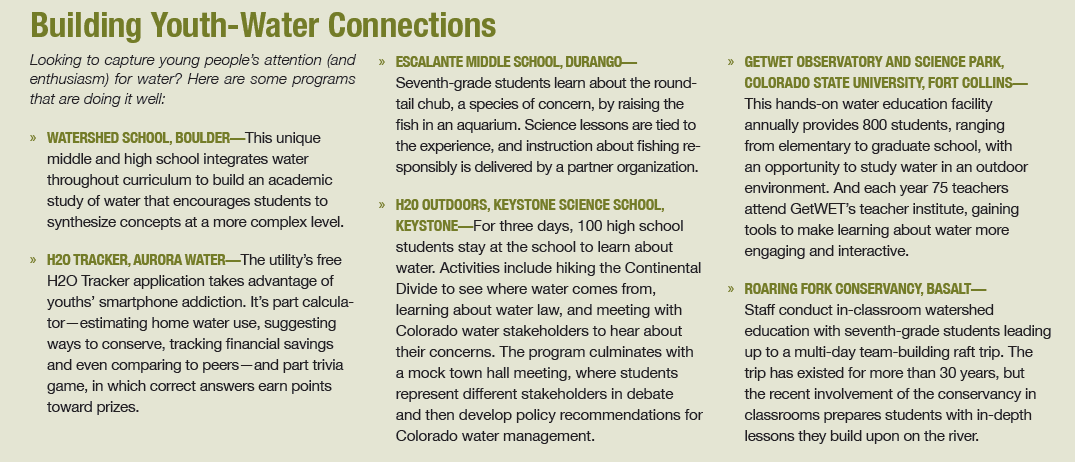“How much water goes into that soccer field?” It’s a question Natalie Brower-Kirton, senior program specialist for Aurora Water, poses to children during her programs. Students have to stop and think: How much water does go into that soccer field?
“The water they drink and use at their house is important,” Brower-Kirton says, “but playing on a soccer field also uses water.” Brower-Kirton’s approach is one many water educators are taking in an age of relative disconnect, short attention spans and technological distractions for young people: bringing concepts home in tangible lessons and activities kids can relate to.
Educators find that youth, like adults, become more engaged in abstractions such as water scarcity when they are given tools to effect change. Water conservation becomes real through trainings on using shower timers to remind them not to linger, replacing leaky toilet flappers, and other simple lessons such as saving 10 gallons a day by turning off faucets while brushing teeth.
Many water educators also look to give children tangible, outdoor experiences, though winning time with schools for such activities can be a challenge, says Mike Wilde, educational consultant at the Roaring Fork School District. The key to success, he says, is finding administrators and educators who buy in to such experiences and tying environmental lessons to other subjects, such as math and English.
Recently, particularly following the Colorado Department of Education’s adoption of the Colorado Environmental Education Plan in late 2012, public schools have been revamping curriculum and looking beyond school walls for ways to fulfill state standards in environmental education, including water. The state plan, created over a two-year period by the Colorado Alliance for Environmental Education and a dedicated task force, is widely considered a step forward in the quest for environmental literacy, as the plan seeks to restore and increase field experiences as well as improve statewide access to existing environmental education programs and materials.
“It creates a sense of excitement and belonging to this place,” says Palumbo. “We teach them that they own the park and can come here for free, but when you own something, it’s also your job to take care of it.”
As a result of the plan, the Greenway Foundation’s South Platte River Environmental Education (SPREE) program began working with two partner schools to present a water-based chemistry unit that extracted children from the classroom. The tools of Colorado’s River Watch program were implemented to link abstract chemistry lessons to real-life water quality issues. For their final project, students used data to recommend a positive change for the river. “It was a real way to make chemistry come alive for students,” says SPREE youth development director Mary Palumbo.
SPREE also organizes grade-specific field trip sites on public land along the South Platte River. Lessons combine with tangible experiences to empower kids to have a positive impact on the environment. “It creates a sense of excitement and belonging to this place,” says Palumbo. “We teach them that they own the park and can come here for free, but when you own something, it’s also your job to take care of it.”



 Print
Print